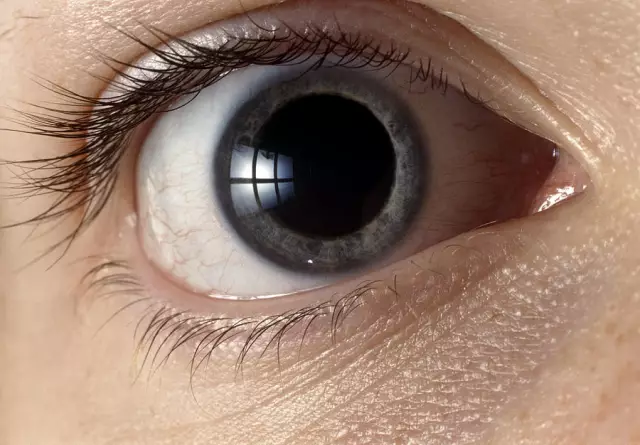- Author Curtis Blomfield [email protected].
- Public 2023-12-16 20:44.
- Last modified 2025-01-23 17:01.
If white spots are observed in the eyes of a person when viewing a photograph, this is a reason to go to an ophthalmologist. Lost red pupil reflex is a sure sign of disease.
In a normal state, blood circulates in a certain way in the retina. That is why the pupils take on the shade familiar to all of us. However, if for some reason blood flow is obstructed, or neoplasms occur in the path of light, the eyes become whitish.
Coat's disease and toxocariasis
Leukocoria (white eye effect) is one of the symptoms of retinal vascular anomalies. This disease is called Coates' disease. It is characteristic that it is more common in men, but often occurs in children. Usually one eye is affected, but it is not uncommon for a bilateral lesion to occur.

Also among the possible ailments is toxocariasis, a parasitic and very common childhood disease caused by helminths. It usually occurs with poor hygiene, contact with waste products and the hair of infected animals. Toxocara can also enter the bodythrough unwashed fruits, soil and dirty water. Intrauterine infection with this disease is very likely, as well as with breastfeeding. This is one of the answers to the question why a newborn baby may have a white pupil.
Fundus tumor and tuberous sclerosis
With retinoblastoma, leukocoria also appears in most cases. It can be detected when the tumor is in the center of the fundus, when it fills most of the space. This disease occurs in children between the ages of two and five. Often inherited.

Tuberous sclerosis is a rare genetic disease characterized by the formation of benign tumors in various organs. This disease is often associated with retinal astrocytoma. In its tissues, a formation appears that undergoes calcification. White pupils of the eyes are a vivid symptom of this pathology.
Cloudy lens
Leukocoria can be caused by cataracts. This is an eye disease in which there is a clouding of the lens. A white pupil in humans is often the result of denaturation of the protein that makes up the vitreous body. The occurrence of cataracts is due to various causes, such as trauma, old age, metabolic problems, ionizing radiation, endocrine diseases, diabetes mellitus, other past infections, and even Down's disease.

Cataract is congenital and acquired, the difference between which is thatthe latter progresses over time. In this case, not only does the pupil become white, but complete blindness is also possible.
Importance of correct diagnosis
Prematurity of a newborn baby can provoke retinopathy, the result of which is retinal detachment. Naturally, when reacting to light, the white-eye effect will be very noticeable.
Leukocoria is dangerous because it is a sign of many serious ailments. Incorrectly diagnosing the disease and prescribing the wrong treatment, you can come to the fact that the patient will completely lose his sight. If the symptom is caused by a malignant tumor, there is a danger of death. Correct diagnosis of diseases in the early stages allows you to count on a positive prognosis and effective treatment.
Examinations and analyzes
To do this, you need to know the age at which the disease was detected, whether there is a family hereditary predisposition to these ailments, whether there was contact with animals.
The doctor must measure the diameter of the cornea, perform a complete ophthalmological examination, assess the condition of the retina and vitreous body (lens).

Fluorescein angiography for Coats disease or retinoblastoma, CT and MRI of the brain and eyes, a blood test for toxocariasis, a visit to a pediatrician or therapist will also be useful.
Depending on the diagnosis, treatment is prescribed.
Possible treatment regimens
For Coats disease stage 1-2 apply lasercoagulation of the retina with the condition that the affected area is not more than 360 degrees. Also, in addition to this method, cryopexy of the eyes can be prescribed, and at later stages - extracleral filling.
In the case of retinoblastoma, the methods of therapy used depend on the severity of the disease. If both the right and left eyes have a white pupil, then the treatment is developed separately for each. Usually prescribed laser and cryotherapy, enucleation and standard surgery. In cases of spread of metastases throughout the body, general chemotherapy is used.
In the treatment of cataracts, the transfer of the disease that provoked the development of pathology (for example, diabetes mellitus) into remission is of decisive importance. Although conservative methods do not completely get rid of the insidious disease, you can pause the process. For this, eye drops are used, such as Taurine, Vita-Yodurol, Perinoxin, Quinax. Also, the complex therapy includes physiotherapy (electrophoresis and others). Only a surgical intervention will help to completely get rid of a cataract, during which the removal of what is left of the lens and the installation of a prosthesis - an intraocular lens in its place.

Toxocariasis is treated with anthelmintic drugs. Steroids can be prescribed and applied, depending on the inflammation, both locally and systemically by parabulbar administration. If there are no visible improvements during treatment, and vision continues to fall, you should think about removing the vitreous body. Cansignificantly reduce the risk of infection with toxocara by carrying out preventive anthelminthic procedures for your pets once a year in a veterinary clinic. You should also remember about your own hygiene and do not forget to wash your hands.
White pupil is a seemingly harmless symptom, which, nevertheless, may indicate a serious illness. If you find it, you should immediately consult a doctor.






